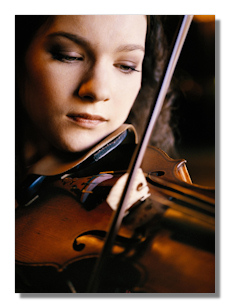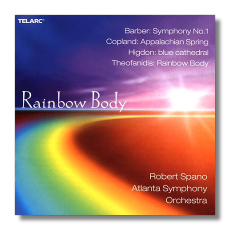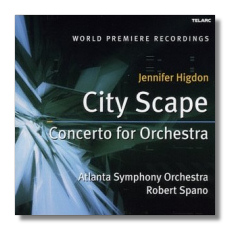
The Internet's Premier Classical Music Source
Related Links
- Higdon Reviews
- Latest Reviews
- More Reviews
-
By Composer
-
Collections
DVD & Blu-ray
Books
Concert Reviews
Articles/Interviews
Software
Audio
Search Amazon
Recommended Links
Site News
 Concert Review
Concert Review
Jennifer Higdon

Violin Concerto World Première
- Also on the program: Schumann's 4th Symphony and Weber's overture to Freischütz
Hilary Hahn, violin
Indianapolis Symphony Orchestra/Mario Venzano
Hilbert Circle Theatre, Indianapolis, Indiana, USA - February 6, 2009
Having just returned from driving 660 miles, round trip, in order to hear this première, I am sure I would be in a major funk had I been in the least disappointed by this concerto. However, I am still exhilarated from hearing this exciting work. It may well be Higdon's best work to date. It is unlike any other work for violin and orchestra I have heard (and I have reviewed here over two dozen of them in the last few years.)
This is very much a concerto for violin and (large) orchestra, in that the woodwinds, brass, percussion and other strings all have interesting things to say, often at the same time the line of the soloist is presenting something else. The good news is that the different voices can be heard without drowning one another out, which is one of the exciting things about this piece. The work is unquestionably complex but, unlike Higdon's Concerto for orchestra, the texture is not dense. (Higdon told me that the latter was meant to be very dense.) That said, this violin concerto is almost a second concerto for orchestra, as the reviewer in the Indianapolis Star also notes. The orchestration includes, besides the usual instruments, an English horn, piccolo (which both have noticeable utterances), tuba, harp and several tuned and untuned percussion instruments, including tubular bells and a glockenspiel struck with #10 knitting needles. The writing for woodwinds is especially satisfying.
The percussion and brass filled the entire rear of the playing area on what would appear to be a two or three foot high riser except that it seems to be a permanent part of the structure of the Hilbert Circle Theatre, surely meant to spare the hearing of the other players.
The concerto is in the usual three movements but with unusual designations. The first is enigmatically denoted "1726," a number Higdon says has meaning to both her and Hahn and she has promised an autographed copy of the score to the first six respondents correctly guessing what this significance is. (I rather hope she will re-name the movement.) The slow movement is called Chaconni (admittedly a neologism) to indicate that the movement has more than one repeated chord progression.
The finale is "Fly Forward," a name that came to Higdon during the Olympics last year when she was working on the movement and which she thought an apt term to apply to what Hahn was going to play. Its tempo is incredibly fast – think of a prolonged Flight of the Bumblebee. I was not alert enough to clock time to note the duration of the concerto accurately, but my estimate is a bit longer than half an hour.
The mood of the work was more lyrical than not. Toward the end of the opening movement there was a passage that was very reminiscent of birds singing and afterwards Higdon confirmed to me that was not an inappropriate characterization. At times at least the concerto also struck me as not unlike music of the English pastoral school (think Vaughan Williams' 8th symphony, for example – but not as though she were quoting – and when I said this to Higdon she did not blanch. In a pre-concert forum Higdon suggested that one might be reminded of Hindemith, as she has played work of his for flute (her instrument.) The dynamics range from very soft to overwhelming at a couple of moments, the tuttis giving the soloist some surely much needed rest. The phrasing is very varied, with an unusual amount of pizzicato, for both soloist and other strings, some fluttering sounds, even from the brass, an undulating passage, some smooth legato from the strings. There is also a wide range of pitch. The concerto opens with high harmonics from the soloist's violin over those knitting needles, for instance, and then of course there is that tuba.
This work was commissioned by the Indianapolis, Baltimore and Toronto orchestras and the Curtis Institute, where Higdon teaches and which Hahn attended (and studied with Higdon, as it happens.) Higdon wrote it expressly for Hahn, keeping in mind the kind of playing she likes and the composer frequently consulted the soloist, as is frequently the case with compositions of this genre. Higdon was concerned whether certain passages, and the cadenza were actually playable or not but she was assured that they were not a problem. It seemed that everything was effortless for her. The person presiding at the pre-concert forum wondered if Hahn would play from memory or from a score but, having (last spring in Milwaukee) asked Hahn if she had the score in hand and how long it would take her to learn it. her answer was "the usual time; learning the notes is the easy part" of preparation.
The audience, which the Star reviewer called "hearteningly large" but at which the empty seats concerned some acquaintances with whom I spoke, gave the concerto a tumultuous ovation. In a brilliantly apt move, Hahn played as an encore an exquisite Sarabande by Bach that could not have been more of a change of pace. There was no need whatever to show her skill at this point and the full rich tone of Hahn's violin sounded wonderful in the fine acoustics of this hall. Someone I spoke with declared that the concert would have been worth attending just for this.
Just a word about the Schumann. Venzago plays Schumann with unusually varied tempos. Not jarring juxtapositions of slow and fast but with smooth but very noticeable slowing down at times which, as he put it, preserve a steady rhythm without a steady tempo. He said that did this with the orchestra that Schumann himself had conducted in Dusseldorf, which is used to steady tempos and he did not know whether this would provoke outrage and they actually liked it enough to ask him to be their "Schumann" conductor. Personally, I would prefer not to hear it this way again, but it was interesting.
My reviews of Higdon's Concerto for Orchestra, City Scape and Blue Cathedral:
Copyright © 2009, R. James Tobin.














